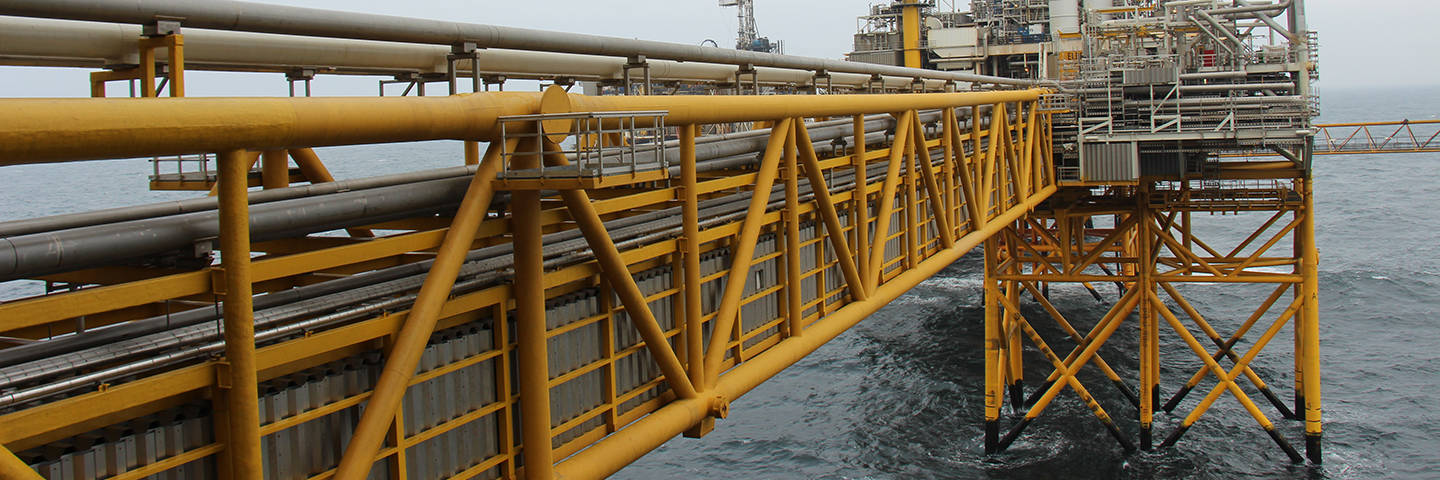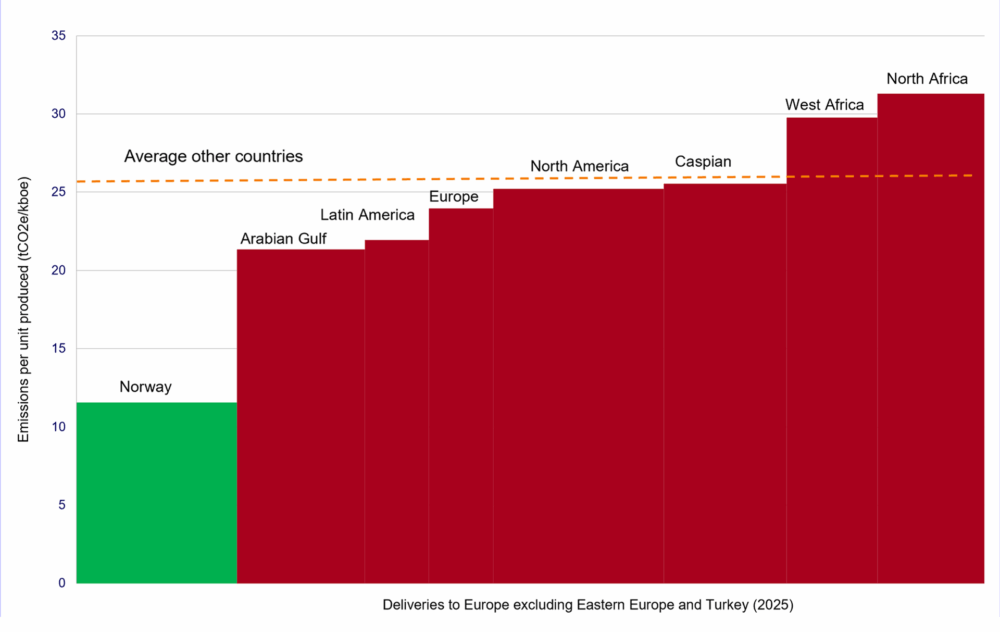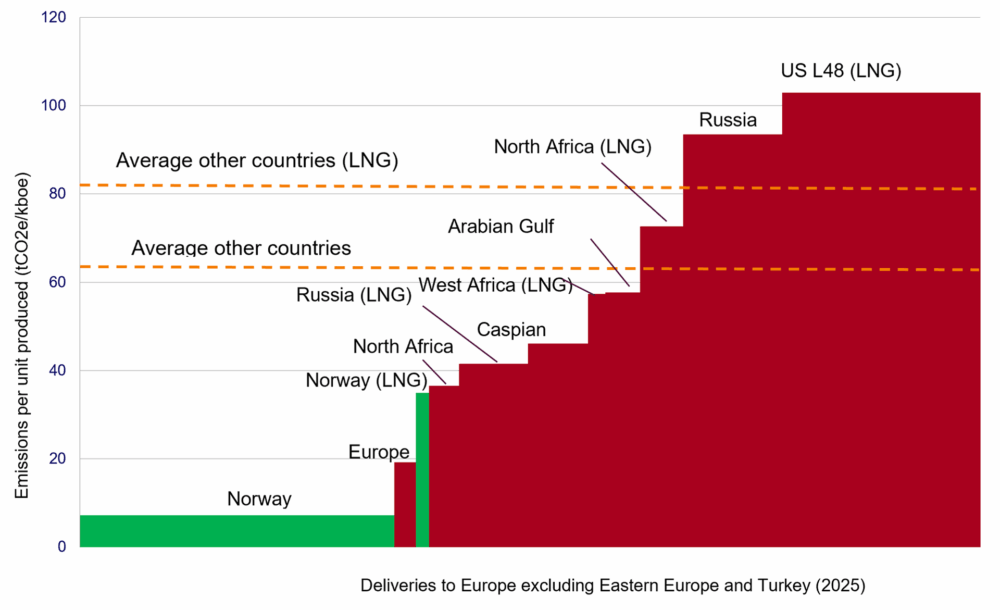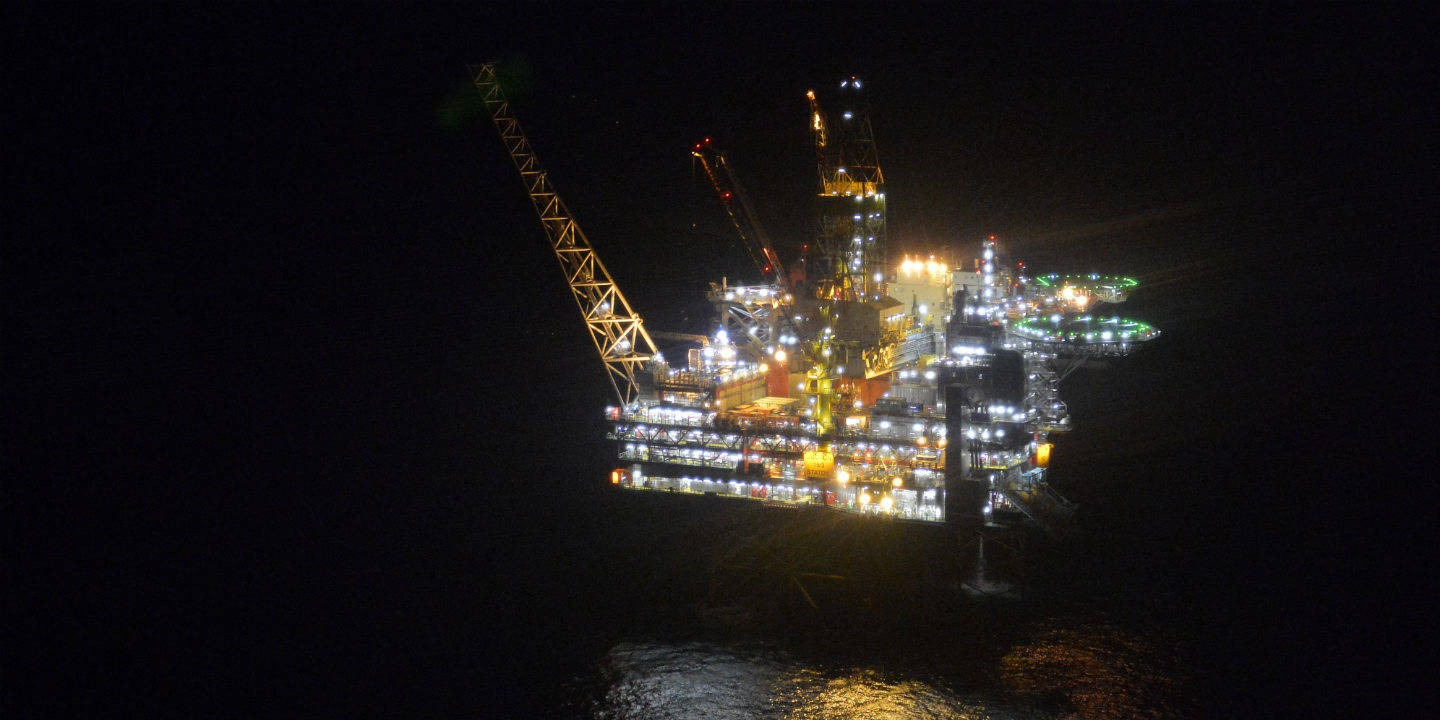Environmental and climate considerations are an integral part of Norway’s policy for the petroleum industry. A range of policy instruments ensures that actors in the industry take environmental and climate considerations into account during all phases of their activities, from exploration to development, operations and field cessation.
Environmental and climate standards in the Norwegian petroleum industry are very high compared with those in other petroleum producing countries. This is a result of effective policy instruments and joint initiatives between the authorities and oil companies on research, technology development and increased knowledge.
Emissions to air from petroleum activities originate from the combustion of natural gas and diesel in turbines, engines and boilers, flaring of natural gas for safety reasons, venting and diffuse emissions of gas, and storage and loading of crude oil. These activities result in emissions of waste gas containing CO2 (carbon dioxide), NOx (nitrogen oxides), NMVOCs (non-methane volatile organic compounds), CH4 (methane) and sulphur dioxide (SO2).
Emissions from Norwegian petroleum activities are regulated through several acts, including the Petroleum Act, the CO2 Tax Act on Petroleum Activities, the Sales Tax Act, the Greenhouse Gas Emission Trading Act and the Pollution Control Act.
Requirements for impact assessments and approval of plans for new developments (PDOs/PIOs) are cornerstones of the petroleum legislation. Facilities onshore and within the baseline are also subject to the provisions of the Planning and Building Act.
Emissions from the petroleum sector in Norway are well documented. The industry’s own organisation, Offshore Norge, has established a national database for reporting all releases from the industry, called Footprint. All operators on the Norwegian continental shelf report data on emissions to air and discharges to the sea directly in Footprint.

In 2024, greenhouse gas emissions from petroleum activities corresponded to about 10,9 million tonnes CO2 eq (carbon dioxide equivalent). Emissions from the petroleum sector account for about one quarter of Norway’s aggregate greenhouse gas emissions.
The projections of emissions from oil and gas production are prepared by the Norwegian Offshore Directorate and are based on reporting from the oil companies. The definition of the petroleum industry follows the definition of the Petroleum Tax Act, except the facility at Kårstø which is also included in the emission scope. Operations at the onshore facilities, which is linked to further transport of gas, are included in the projections at Statistics Norway (SSB), so that the projections are in line with the emissions greenhouse gas inventory accounts. Emissions from the construction and installation phase, maritime support services and helicopter traffic are included in other industries.
CO2 emissions from the petroleum sector are expected to be relatively stable the next few years.
Greenhouse gas emissions from the petroleum sector
Updated: 11.06.2025
Historical numbers for 2000-2023 and projections for 2024-2029
Source: Norwegian Offshore Directorate
Print illustration Download data Greenhouse gas emissions from the petroleum sector Download PDF Download as image (PNG)
High Contrast Mode
Emissions vary across different fields, both in Norway and internationally, but on average, emissions from the Norwegian continental shelf are significantly lower per unit produced. The emission figures include both CO₂ and methane and cover production, processing, and transport. For oil, emissions per unit produced from other countries are on average more than twice as high as those from Norway. For gas, emissions associated with LNG from other countries – which supply the marginal demand in Europe – are more than 11 times higher per unit produced than pipeline gas from Norway.
Emissions per unit of oil and condensate produced and delivered to Europe (Rotterdam)
Source: Wood Mackenzie

Emissions per unit of pipeline gas and LNG produced and delivered to the European market (pipeline gas unless otherwise specified)
Source: Wood Mackenzie

The companies operating on the Norwegian shelf are front runners in the use of solutions to reduce and prevent greenhouse gas emissions. Emissions per unit of oil and gas produced are therefore lower compared to similar operations in other petroleum-producing countries.
Energy efficiency measures, including the introduction of energy management systems and the installation of more energy-efficient equipment such as compressors and pumps, have helped to reduce emissions from petroleum activities. Combined-cycle gas turbines (CCGT) are one technological solution, in which waste heat from the turbines is used to produce steam, which in turn is used to generate electricity. CCGT plants improve energy efficiency and reduce emissions. They are installed at the fields Oseberg, Snorre and Eldfisk.
Since 1996, the separation and storage of CO2 from the gas at Sleipner Vest has been ongoing. At most, one million tonnes of CO2 was separated and stored annually under the seabed in the Utsira Formation. Since 2019, CO2 from the gas to Utgard has also been stored in the Utsira Formation. The background for CO2 separation for gas from Sleipner Vest and Utgard was that the CO2 content in the gas was too high to be sold to the market. Hammerfest LNG on Melkøya separates CO2 from the well stream before the gas is chilled to produce liquefied natural gas (LNG), and has been doing so since 2008. The CO2 is transported back to the field, injected and stored.
The largest emissions on the Norwegian continental shelf come from energy production, which mainly occurs through the combustion of gas in turbines on platforms. Supplying power from the onshore electricity grid to offshore installations and onshore facilities has therefore been an important measure to reduce emission from the petroleum industry.
Today, the fields Johan Sverdrup, Edvard Grieg, Ivar Aasen, Gina Krog, Ormen Lange, Snøhvit, Troll A, Goliat, Valhall, and Martin Linge are supplied with power from shore. This includes that third-party fields connected to the installations are also electrified. Additionally, the Sleipner and Gjøa fields are partially electrified. In addition, the onshore facilities at Kårstø, Kollsnes, Melkøya LNG, and Nyhamna (including the subsea facilities on the Ormen Lange field) are supplied partly or wholly with power from the grid. Power from shore to Draugen, Njord, Troll B and C, Oseberg field centre and Oseberg Sør is also under development.
In 2023, Hywind Tampen, Norway’s first floating offshore wind farm, was completed and put into full operation. Hywind Tampen is the first wind farm in the world to supply power to oil and gas installations and is connected to the Gullfaks and Snorre fields.
CO₂ emissions from petroleum activities in 2024, by source
Updated: 11.06.2025
Source: Norwegian Offshore Directorate
Print table Download data CO₂ emissions from petroleum activities in 2024, by source
The carbon tax and the Greenhouse Gas Emission Trading Act are Norway’s most important cross-sectoral climate policy instruments for cost-effective cuts in greenhouse gas emissions. Both of these instruments apply to the majority of emissions from petroleum industry, while most other sectors either have to take part in emissions trading or pay the carbon tax.
The carbon tax
Norway was one of the first countries in the world to introduce a carbon tax, in 1991. The tax is levied on all combustion of gas, oil and diesel in petroleum operations on the continental shelf and on releases of CO2 and natural gas, in accordance with the CO2 Tax Act on Petroleum Activities. For 2024, the tax rate is at NOK 1.85 per standard cubic metre of gas and NOK 2.10 per litre of oil or condensate. For combustion of natural gas, this is equivalent to NOK 790 per tonne of CO2. For emissions of natural gas, the tax rate is NOK 16,89 per standard cubic metre.
For 2025, the carbon tax is NOK 2,21 per standard cubic metre of gas and NOK 2.51 per litre of oil or condensate. For combustion of natural gas, this corresponds to NOK 944 per tonne of CO2. For emissions of natural gas to air, the rate is NOK 20.17 per standard cubic meter.
Greenhouse Gas Emission Trading
Norway’s Greenhouse Gas Emission Trading Act entered into force in 2005, and Norway joined the EU Emissions Trading System (EU ETS) in 2008. This means that Norwegian installations in the petroleum industry and other industries to which the system applies are subject to the same rules for emissions trading as those within the EU. The EU ETS is now in its fourth phase, which runs up to the end of 2030.
The EU ETS is a ‘cap and trade’ system, which sets a ‘cap’, or limit, on total greenhouse gas emissions within the system. This cap is reduced year by year so that the emission target for sectors covered by the system is met by the end of the period. Emission allowances are allocated by auctioning or free of charge. Sectors that are considered to be at risk of carbon leakage receive some or all of their allowances free of charge. This applies to a certain proportion of petroleum-sector emissions to which the ETS applies.
In 2024, the average cost of an emission allowance entitling the holder to emit one tonne of CO2 was approximately 66,60 euros, corresponding to approx. NOK 775.
The combination of the carbon tax and the emissions trading system means that companies on the Norwegian shelf pay approx. NOK 1565 per tonne for their CO2 emissions, which is significantly higher than for most other businesses in Norway and much higher than in other countries with petroleum activities. Accrued domestic carbon tax in 2024 was at NOK 7,6 billion. Emissions from the petroleum sector subject to the EU ETS was around 10,5 million tonnes in 2024. With average 2024 EU ETS price and exchange rate this corresponds to a total carbon credit cost of around NOK 8,1 billion. Combined, this means that the companies on the Norwegian shelf had a total emission cost of approx. NOK 16 billion. Actual paid emission cost could be somewhat lower due to free of charge carbon credit allocations.
Permits and other requirements
Before the licensees can develop a discovery, their plan for development and operation (PDO) must be approved by the Ministry of Energy. The PDO contains information on how the licensees intend to develop and operate the field. Whenever proposals are made for new field developments or large-scale modification of existing facilities, the operator must as part of the PDO include an overview of energy needs and an assessment of the costs of using power from shore rather than gas turbines to supply electricity.
Flaring of natural gas is only permitted when necessary for safety reasons. Permit for flaring are issued by the Ministry of Energy.
A permit under the Pollution Control Act is required for emissions to air from petroleum operations.
NOx emissions
The petroleum sector accounts for about a quarter of Norway’s total NOx emissions.
NOx is a generic term for two oxides of nitrogen, NO and NO2. They cause acidification of river systems and soils, which has direct environmental impacts including harm to fish, wildlife and ecosystems. NOx emissions also have indirect impacts because they are involved in the formation of ground-level ozone, which can damage vegetation and materials. In addition, NOx can trigger respiratory complaints. Studies show that the environmental impacts of NOx emissions vary considerably depending on where they take place, and that emissions in urban areas have the most serious effects.
CO2 and NOx emission levels are closely linked. The main sources of NOx emissions from offshore installations are the same as for CO2: combustion of gas and diesel in turbines and engines. The level of emissions depends both on the technology used and on fuel consumption.
Under the revised Gothenburg Protocol, Norway has undertaken a commitment to reduce its overall NOx emissions by 23 % in 2020 compared to the 2005 level. This commitment was achieved in 2017. Emissions from the petroleum sector are directly regulated by means of conditions included in plans for development and operation (PDOs) and in permits under the Pollution Control Act.
In 2007, Norway introduced a tax on NOx emissions to encourage cost-effective emission cuts. For the petroleum industry, the tax applies to emissions from large gas turbines and machinery, and from flaring. Businesses that are affiliated with the environmental agreement between the Norwegian state and a number of business organisations on measures to reduce NOx emissions are exempted from the tax.
Most companies in the petroleum sector have chosen to participate in this agreement, and pay a contribution of NOK 17,5 per kg NOx to the NOx Fund in 2024. For companies in other branches of industry, the contribution is NOK 11,5 per kg NOx. The fund’s income is used to support investments by companies that are parties to the agreement to reduce their NOx emissions.
Historical and projected emissions of NOx from the petroleum sector in Norway
Updated: 11.06.2025
Historical numbers for 2000-2024 and projections for 2024-2029
Source: Norwegian Offshore Directorate
Print illustration Download data Historical and projected emissions of NOx from the petroleum sector in Norway Download PDF Download as image (PNG)
High Contrast Mode
NMVOC emissions
The petroleum sector accounts for about a sixth of Norway’s total NMVOC emissions and the main sources of NMVOC emissions are storage and loading of crude oil offshore. Gas terminals are another smaller source of these emissions.
Since the early 2000s, NMVOC emissions from the petroleum sector have been substantially reduced, mainly as a result of investment in NMVOC recovery equipment. In 2024 the total NMVOC emissions were about 21,5 thousand tonnes.
Under the revised Gothenburg Protocol, Norway has undertaken a commitment to reduce its overall NMVOC emissions by 40% from 2020 compared with the 2005 level. Emissions from the petroleum sector are directly regulated through requirements on the use of the best available techniques (BAT) and specific emission limits in permits under the Pollution Control Act.
NMVOCs stands for non-methane volatile organic compounds, and is a generic term for organic compounds that readily evaporate from oil, with the exception of methane. In the presence of sunlight they contribute to the formation of ground-level ozone, which can cause damage to health, vegetation and materials.
In addition, direct exposure to NMVOCs can cause respiratory problems, and they contribute indirectly to the greenhouse gas effect because CO2 and ozone are formed when NMVOCs react with oxygen in the atmosphere.
Historical and projected emissions of nmVOC from the petroleum sector in Norway, 2000-2029
Updated: 11.06.2025
Source: Norwegian Offshore Directorate
Print illustration Download data Historical and projected emissions of nmVOC from the petroleum sector in Norway, 2000-2029 Download PDF Download as image (PNG)
High Contrast Mode
